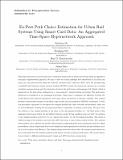Ex Post Path Choice Estimation for Urban Rail Systems Using Smart Card Data: An Aggregated Time-Space Hypernetwork Approach
Author(s)
Mo, Baichuan; Ma, Zhenliang; Koutsopoulos, Haris N; Zhao, Jinhua
DownloadAccepted version (2.613Mb)
Open Access Policy
Open Access Policy
Creative Commons Attribution-Noncommercial-Share Alike
Terms of use
Metadata
Show full item recordAbstract
This paper proposes an ex post path choice estimation framework for urban rail systems using an aggregated time-space hypernetwork approach. We aim to infer the actual passenger flow distribution in an urban rail system for any historical day using the observed automated fare collection (AFC) data. By incorporating a schedule-based dynamic transit network loading (SDTNL) model, the framework captures the crowding correlation among stations and the interaction between the path choice and passenger left behind, which is important for the path choice estimation in a “near-capacity” operated urban rail system. The path choice estimation is formulated as an optimization problem, which aims to minimize the difference between the model-derived and observed information with path choice parameters as decision variables. The original problem is intractable because of nonlinear (logit model) and nonanalytical (SDTNL) constraints. A solution procedure is proposed to decompose the original problem into three tractable subproblems, which can be solved efficiently. Solving the decomposed problem is equivalent to finding a fixed point. We prove that the solution to the original problem is the same as the decomposed problem (i.e., the fixed point) when passenger path choices follow the predefined behavior model. If this condition does not hold, the solution of the original problem is proved to be an “almost fixed point” for the decomposed problem. The model is validated using both synthetic and real-world AFC data from a major urban railway system. The analysis with synthetic data validates the model’s effectiveness in estimating path choice parameters and left behind probabilities, which outperforms state-of-art simulation-based optimization methods and probabilistic models in both accuracy and efficiency. The analysis using actual data shows that the estimated path shares are more reasonable than the baseline uniform path shares and survey-derived path shares. The model estimation is robust to different initial parameter values and AFC data from various dates.
Date issued
2023-03Department
Massachusetts Institute of Technology. Department of Civil and Environmental Engineering; Massachusetts Institute of Technology. Department of Urban Studies and PlanningJournal
Transportation Science
Publisher
Institute for Operations Research and the Management Sciences
Citation
Mo, Baichuan, Ma, Zhenliang, Koutsopoulos, Haris N and Zhao, Jinhua. 2023. "Ex Post Path Choice Estimation for Urban Rail Systems Using Smart Card Data: An Aggregated Time-Space Hypernetwork Approach." Transportation Science, 57 (2).
Version: Author's final manuscript